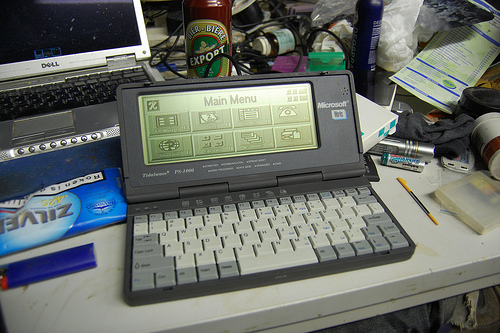DOS Palmtop: Tidalwave PS-1000 Details and specs
Tidalwave PS-1000 (Master Tidalwave PS-1000)

About this machine:
Although barely known and rarely seen the Tidalwave PS-1000 definitely IS an interesting machine. What few people know is that even though they
have never seen a Tidalwave PS-1000 they might have had one in their hands without knowing it. Why? Because Tidalwave is the company that made the
hardware. Not for all palmtop PCs of course but for a fair number of machines sold under various brands all over the world. Ironically machines
marketed under their own brand name are probably the ones that sold worst so a real "Tidalwave" brand pocket PC is usually quite hard to get.
I have listed all other OEM versions of the tidalwaves as "Tidalwave clone". Actually it is more of an OEM version than a clone as tidalwave
indeed produced at least all the internals, but probably also all of the casings. Tidalwave was a computer accessory manufacturer in the late 80s
and early 90s which was based in Taiwan. Originally they were probably best known outside of Taiwan for their cheap modems and CGA graphics cards.
However, at some point in 1992 they started flooding worldwide markets with their palmtop PC (They originally named it "PS-1000", which supposedly means "Palm Star 1000"), not without the help of international computer companies that gladly distributed these machines under their own brand name. All these "clones"
were released with the exact same hardware and software, the only difference being localized versions - so machines sold in germany for example had
a German keyboard and menus in German. What was also usually quite similar was the comparably low price - somwhere around 600 USD in 1992.
My guess is that Tidalwave just produced immense amounts of these machines and as they made many of the chips themselves they could
produce it dirt cheap and contacted loads of distributors worldwide to offer branded versions at a very low price. The price is actually what i
think was the main reason these sold quite well - if you keep in mind that comparable machines by Sharp or Fujitsu were still above the 1000 Dollar
mark at that time these Tidalwave models just screamed "Bargain" into the customers face. Technically these machines were not really impressive
when compared with the competition, but at least mostly on par. However PCMCIA Type I slots only accepting SRAM cards is definitely a drawback and
also the power management of the HP and Poqet machines was a bit better. A big surprise is the included software though - with microsoft works you
at least get a really usable spreadsheet, database and word processing solution included. The quality of the plastic is not too great but around 20
years later most devices are still in good shape so it's not total trash although it "feels cheap". The display is quite large and readable and
with the analog contrast wheel you can adjust it to most lighting conditions. All in all a large but still quite usable Palmtop PC. While some sources
claim these models might have existed in 1991 i have never found any traces of that. Maybe demonstration devices were available but the Microsoft Works
"ROM Edition" included on these was always dated from 1992 on machines i saw myself. To tell if a machine is a Tidalwave clone without opening it (And looking
at the Tidalwave labeled chip in the middle of the motherboard) just check the following typical features:
- Reset key hidden in upper right corner between Backspace and On/Off keys
- Contains MS Works 2.0 and MS-DOS 5.0
- Has 2 PCMCIA Type I slots
- LED indicators for Caps, Num and Scroll lock on upper left side of the keyboard
If all 4 are true then it is definitely a Tidalwave.
Specs:
CPU: NEC V30 @ 7.15 MHz
Graphics: Monochrome CGA, 80 x 25 character text mode, CGA 2 color monochrome graphics mode
Display: 640 x 200 monochrome Supertwist LCD , 4 grey scales, 7.2 inch
Memory (RAM): 1 MB
ROM (Software): 1.5 MB
I/O ports: RS232 Serial (proprietary cable was included accessory), PCMCIA 1.0 Type I slot, Parallel port (proprietary cable included)
Sound: PC Speaker - Piezo
Operating System: MS-DOS 5.0
Software: MS Works 2.0, RacePen PIM (File manager, scheduler, phone book, etc), Microsoft QBasic
Size: Length 11.5 cm, Width 24.5 cm, Height 2.5 cm (4.5 inches x 9.7 inches x 1 inch)
Powered by: 2 AA batteries - rechargable or non-rechargable or AC adaptor (optional accessory), CR2032 Lithium button cell as memory backup
Weight: 590 gram (21 ounces) including 2 standard AA and CR2032 batteries
Special features: None
Released: 1992
Originally retailed for:: 595 USD
Clone of: Not a clone. However all other models based on it can be considered clones.
Similar models: Zeos Pocket PC, Highscreen Handy Organizer and all other clones
Pros:
- Fully CGA compliant, so most CGA based DOS appz and games work
- Excellent keyboard
Cons:
- No support for flash cards
- Not really the smallest Palmtop ever
- Power management is rather average
- No way to boot a different OS and no way to bypass loading the drivers for cards and keyboard
Collector Value:
8 of 10
Usage Value:
7 of 10
Verdict:
Give it a usability value of 10/10 if you don't care about CF cards. The original is also unfortunately one of the rather rare palmtop models. However if
you don't care about the brand name on the lid you can also get any of the clones and have the exact same machine. The large keyboard and display
along with the useful MS Works make this a quite useful companion in any edition.
Back to the Palmtop PC index
